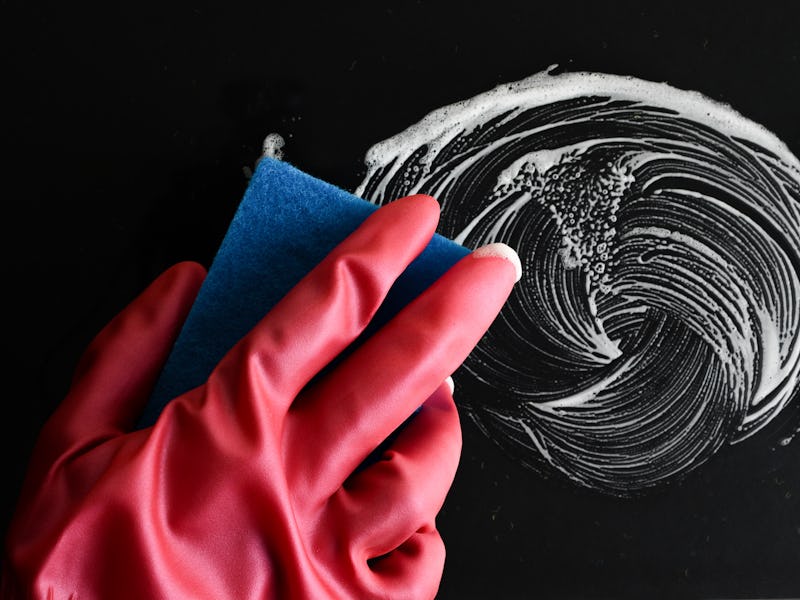Everything to know about Covid-19 and surfaces
But first, don't panic.

During a typical day, we touch the surfaces of many different objects, often without noticing: money, phones, door handles, elevator buttons, cups, desks, keyboards, petrol pumps, and shopping carts.
Objects with surfaces that carry pathogens (such as bacteria or viruses) can pass on infections when we touch them. So it makes sense contact with these contaminated surfaces (often called “fomites”) might increase our infection risk.
Now a study published by CSIRO researchers suggests SARS-CoV-2, the virus that causes Covid-19, can survive up to 28 days on common surfaces.
So, is this cause for panic? The answer is, not necessarily.
What did the study find?
The researchers applied SARS-CoV-2 to Australian plastic banknotes, paper banknotes, stainless steel, glass, vinyl, and cotton cloth.
They exposed the objects to three different temperatures — 20℃, 30℃, and 40℃ — all in the dark and with 50% humidity. They then measured the amount of surviving live virus over time.
At 20℃, the virus survived longer (up to 28 days) on smooth surfaces, such as glass and banknotes (both plastic and paper), than on porous surfaces such as cotton.
At 30℃ the virus was not detected beyond day seven on any surface except paper banknotes, where it survived up to day 21.
At 40℃, the virus was rapidly inactivated, meaning it couldn’t cause infection.
What does this mean for our daily routine?
The study was designed to mimic the spread of the virus indoors on surfaces under dark conditions only. In Australia, 28 days of darkness would not be considered normal.
However, this is the first study to show long-term survival (28 days) of the virus on non-porous surfaces such as glass, steel, and banknotes.
Previous studies indicated the virus survives for much shorter periods. This is from a few hours to less than seven days, inside, at temperatures under 25℃, and in lit environments with varying humidity.
Although the CSIRO findings are scientifically significant, their relevance to the everyday transmission of the virus remains uncertain.
Where does this leave us?
Many of the object surfaces we touch certainly deserve consideration as sources of SARS-CoV-2 transmission. However, how long the virus survives on them depends on several environmental and other factors, not all of which researchers have sufficiently studied.
Light
Could expose the object surfaces to light have affected the results? At this stage, we just don’t know.
Other researchers have looked at the ability of a form of ultraviolet light (known as UVC) to inactivate the virus.
However, this form is not abundant in sunlight. So we cannot simply leave objects (possible fomites) in the sun hoping to deactivate any potential viruses hitching an unwelcome ride.
This and other research means we still don’t fully understand the impact of sunlight or other sources of light on the viability of the virus on common objects under everyday conditions. This could be in the home, workplaces or shopping centers, or in enclosed spaces such as in cars or on public transport.
Most of the research so far on using light to inactivate the virus has focused on hospitals or other controlled settings, and using artificial light.
Humidity
Humidity is also likely to play a role in the survival of SARS-CoV-2, but there is no certainty of what the role is.
Most studies analyzing humidity have been observational, meaning researchers are observing the spread of viruses in a population under certain weather conditions.
So far observations are that increasing humidity may be worse for virus survival.
This has also been demonstrated in a laboratory, with increasing humidity decreasing the virus’ survival on fomites. However, we’re not certain whether this is relevant to everyday life.
Type of secretion
We know the virus is mainly transmitted through the air, by inhaling respiratory secretions containing the virus.
While there is an ongoing debate about whether the virus is spread via droplets or is airborne, this is merely a debate on how small a particle can be while still successfully transferring the virus and causing infection.
Research to conclusively prove SARS-CoV-2 can be transmitted via microparticles (5 micrometers or less, the definition of airborne transmission) is still ongoing.
For now, if a SARS-CoV-2 infected person coughs, sneezes, or wipes respiratory secretions onto an object, this object may become a fomite.
In a nutshell
The CSIRO study furthers our understanding of SARS-CoV-2. However, it does not suggest fomites are a significantly greater source of infection than what we are currently managing with existing Covid-19 hygiene practices.
We need to continue frequently washing and sanitizing our hands and surfaces, wearing personal protective equipment such as masks if in high-risk situations or when mandated, and physically distancing.
This article was originally published on The Conversation by Lara Herrero & Eugene Madzokere, both at Griffith University. Read the original article here.